Books
Books

Margery Kempe
First published in 1994, Robert Glück’s Margery Kempe is one of the most provocative, poignant, and inventive American novels of the last quarter century.
The book tells two stories of romantic obsession. One, based on the first autobiography in English, the medieval Book of Margery Kempe, is about a fifteenth-century woman from East Anglia, a visionary, a troublemaker, a pilgrim to the Holy Land, and an aspiring saint, and her love affair with Jesus. It is complicated. The other is about the author’s own love for an alluring and elusive young American, L. It is complicated. Between these two Margery Kempe, the novel, emerges as an unprecedented exploration of desire, devotion, abjection, and sexual obsession in the form of a novel like no other novel.
Robert Glück’s masterpiece bears comparison with the finest work of such writers as Kathy Acker and Chris Kraus. This edition includes an essay by Glück about the creation of the book titled "My Margery, Margery's Bob."

Motion Sickness
At once dreamlike and tough, hilarious and melancholic, Motion Sickness is a contemporary picaresque in which a young woman drifts and reinvents herself with every new encounter.
For the narrator of Motion Sickness life is an unguided tour, populated with hotels and strangers, art, books, and films. Adrift in Europe, her life becomes a carousel of unusual encounters, where coincidences and luck shape la vita nuova.
In London our narrator is befriended by an expatriate American Buddhist and her mysterious husband. In Paris she meets Arlette, an art historian obsessed with Velazquez’s painting ‘Las Meninas’. In Barcelona she meets two generations of Germans. She tours the hill towns of Italy in a London taxi with two surprising Englishmen in pursuit of art and Henry Moore. She buys postcards to send, but often tears them up, not sure of what the pictures mean.
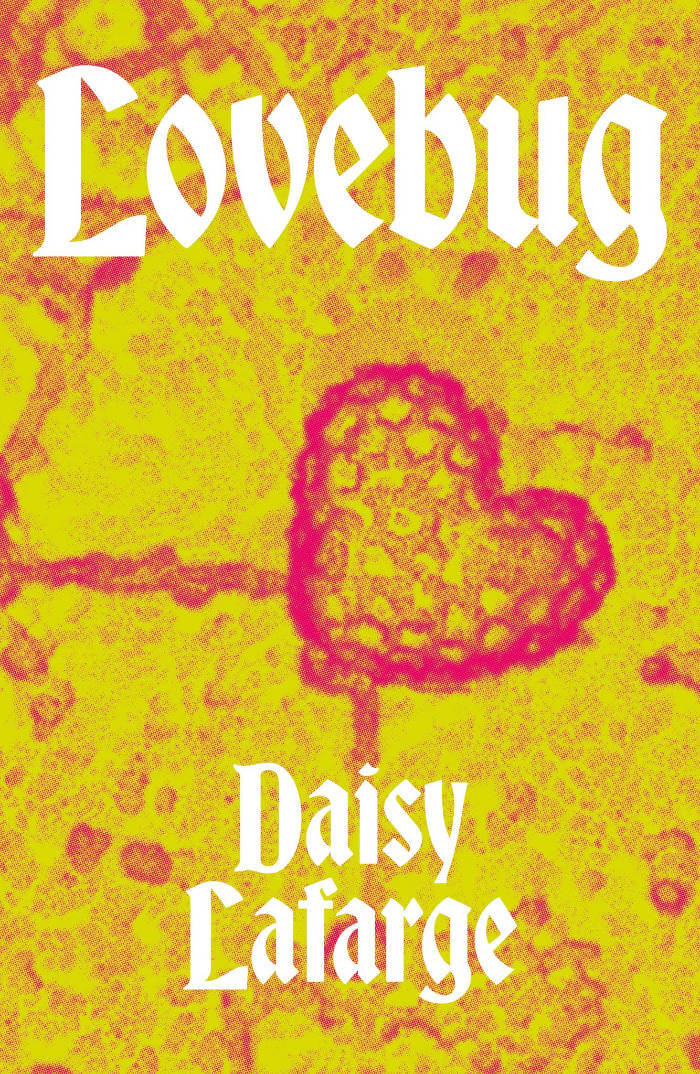
Lovebug
In Lovebug, Daisy Lafarge explores metaphors of love and disease as she seeks to understand human vulnerability and our intimacy with microbial life.
Turning to microbiology, mysticism, and psychoanalysis – as well as the raw materials of love and life – Lafarge navigates the uncomfortable intimacy between the human body and the many bacteria, viruses, and parasites to which it is host.
Lovebug is a book about the poetics of infection, and about how we can learn to live with multispecies ambivalence. How might we forge non-phobic relationships to our ‘little beasts’? How might we rewild our imaginations? In weaving the personal with the pathological, Lovebug complicates the idea of coherent selfhood, revealing life as a site of radical vulnerability and an ongoing negotiation with limit.
"The pathogen arrives anyway and takes a seat at the table. Conditioned to welcome damage, I am curious about this uninvited guest. You must sit down, says Love, and taste my meat".

Border Wisdom
In his second book of poems, Ahmad Almallah seeks a language that captures the afterlives of the mother tongue. This collection blurs the borders between languages, between the living and the dead, between presence and absence.
The poems of Border Wisdom break and mourn physical borders at the same time. Here the exilic idea of a return to a home is expressed in the daily return to the blank page in search of a poem. In these returns the body brushes against the past and, as Hart Crane puts it, taps into "that memory all things nurse."
"In Border Wisdom, Ahmad Almallah takes the notable step of writing in a mix of Arabic and English scripts, a bilingual poetics that has surfaced intermittently among the finest of our experimental writers. For this and for his exemplary writings in standalone English, I would extend to him the well-known welcome that Emerson directed to Whitman nearly two centuries ago: I greet you at the beginning of a great career."—Jerome Rothenberg
Ahmad Almallah grew up in Bethlehem, Palestine and currently lives in Philadelphia where he is an artist-in-residence in Creative Writing at the University of Pennsylvania. His first book of poems, Bitter English, was published in the Phoenix Poets Series from the University of Chicago Press in 2019. He received the 2018 Edith Goldberg Paulson Memorial Prize for Creative Writing, and his sequence of poems “Recourse,” won the 2017 Blanche Colton Williams Fellowship. His poems have appeared in Jacket2, Track//Four, All Roads Will Lead You Home, Apiary, Supplement, SAND, Michigan Quarterly Review, Making Mirrors: Righting/Writing by Refugees, Cordite Poetry Review, Birmingham Poetry Review, American Poetry Review, and Poetry, among others.

nnn4. - no no no celestial journal
published commonly, no no no expounds an experimental poetic offering, both text & art.
each issue features a limited edition artwork. which can be tacked or framed or stored in a drawer.
celestial in nature, no no no takes the form required, and necessary.
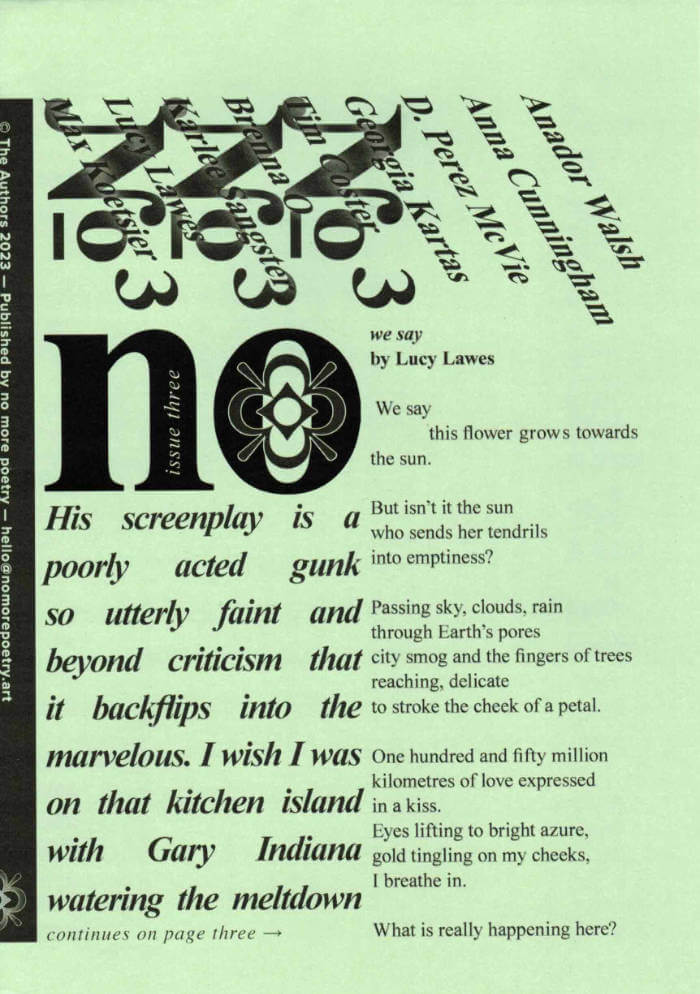
nnn3. - no no no celestial journal
published commonly, no no no expounds an experimental poetic offering, both text & art.
each issue features a limited edition artwork. which can be tacked or framed or stored in a drawer.
celestial in nature, no no no takes the form required, and necessary.

nnn2. - no no no celestial journal
published commonly, no no no expounds an experimental poetic offering, both text & art.
each issue features a limited edition artwork. which can be tacked or framed or stored in a drawer.
celestial in nature, no no no takes the form required, and necessary.
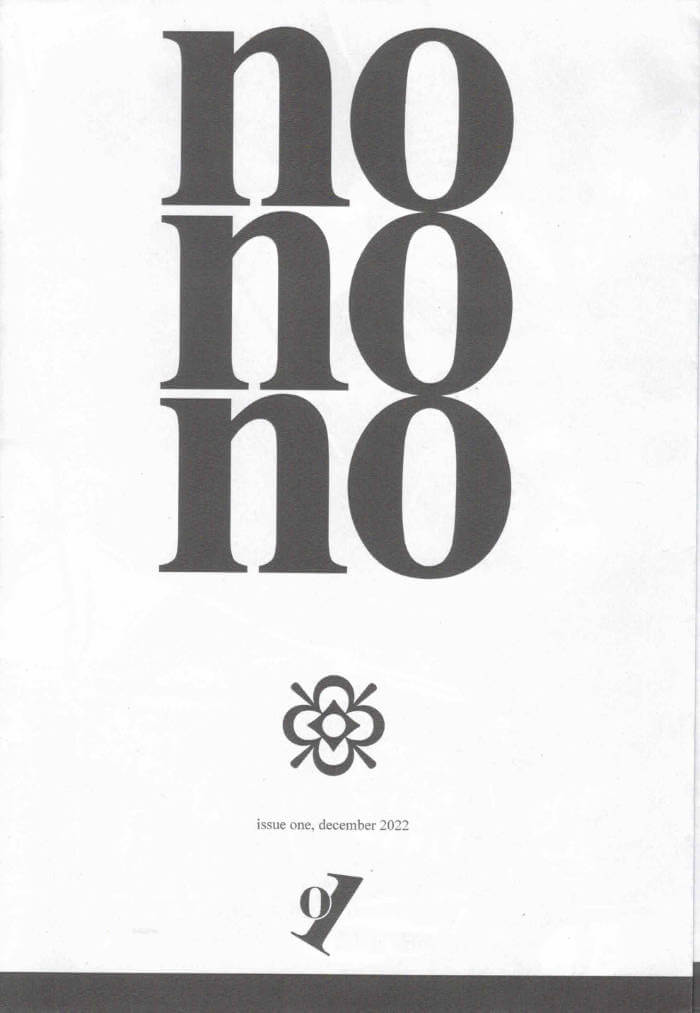
nnn.1 - no no no celestial journal
published commonly, no no no expounds an experimental poetic offering, both text & art.
each issue features a limited edition artwork. which can be tacked or framed or stored in a drawer.
celestial in nature, no no no takes the form required, and necessary.

nmp.07 - drone
no more poetry presents drone, the debut collection from poet felix garner-davis. the book is simple, in that it directs us where to look. high up in the apartment of words the poet offers the audience a window, from which the abundance, beauty, pain and peculiarity of the world can be observed. the poet boldly enacts the role of surveyor, of witness and of voyeur, and asks that we follow suit.
the poems offer new perspectives for which to frame the mechanical and the natural, the quiet and the dizzying. with precision and generosity garner-davis offers an inquisitive consideration of people and their many strange performances within time. the poet asks the audience to join him as the grounded witness; to pause and breath, and in turn celebrate one’s hereness. the poem sings of our aliveness! garner-davis places the reader firmly by his feet, neck tilted against the glass pane of the building or the taxi-cab or the train or the motorcar. thrust into the streets that carry the great disconnect of living; of lives separated and alien, and yet so proximal to our own. this is a book of city poems, guided by the poet, whom we may also call the drone. this is a book that collects many small songs of the everyday and asks us to sing them. drone is a celebration of moments and their endurance
felix is a writer, spoken-word artist & architecture student. he lives in naarm & co-edits the literary journal malevolent soap.
nmp.07:
2021, english — metallic paperback
164 pages — 108 x 178 mm
first edition, edition of 200 (numbered)

nmp.16 - Certainly (certainly)
Rachel Schenberg, Jordi Infeld
This book emerged out of a collaborative writing project that began in 2020 in response to The 3:15 Experiment. The ‘experiment’ involved a group of poets who, every August, would write nightly at 3:15am from wherever they were. It began in 1993 with six poets (Bernadette Mayer, Danika Dinsmore, Jen Hofer, Kathleen Large, Lee Ann Brown, and Myshel Prasad) at the Jack Kerouac School of Disembodied Poetics (Naropa University, Colorado), then continued every August for 22 years, with the group growing to over 25 poets, participating from various time-zones. Four of the initial poets—Mayer, Dinsmore, Hofer, and Brown—compiled The 3:15 Experiment (Owl Press, 2001), a selection of their middle-of-the-night writings between 1993-2000.
This edition builds further on this practice.
"We started thinking about a reading and writing practice that is shared but still divisible, divisible but not subtractable. The structures created by synchronicity, repetition, and temporal constraint felt generative. We found that these structures produced the conditions for another logic to emerge, a night-time logic. This night-time logic gestured to a different kind of self perhaps, a self somewhere between a waking-I and a sleeping-I, a self emerged through habit. After all, logic is just a habit.
This nightly rhythm has now become a yearly ritual: every October we’ve returned to this shared practice. As Jen Hofer says, it’s just “to see what is there. Merely what is there, merely to see.”(2) The poems in this book have been compiled from our first batch of 1:53’s. We edited them ‘together-together’—together trying to attune to each poem’s internal logic, while also trying to locate a collective voice that (we hope) textures throughout.
(Certainly) any writing idea of Bernadette’s is one worth pursuing. This book is dedicated to Bernadette Mayer (1945-2022), and the certainty of possibility her work opens up to us."
on nmp.16:
english, chicago screw, folio cover, 148 x 210 mm
first edition, edition of 115 (numbered).
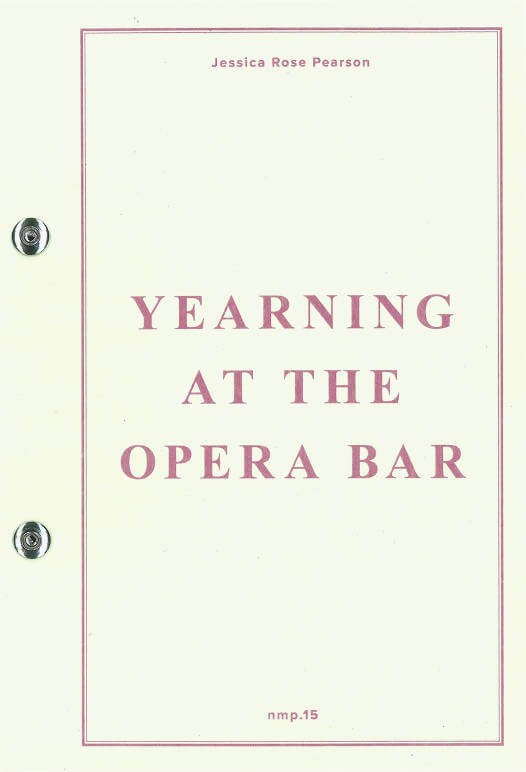
nmp.15 - YEARNING AT THE OPERA BAR
Enter into Jessica Rose Pearson’s debut poetry collection Yearning At The Opera Bar:
The curtain opens on a girl or girl-like thing, early 20’s, laying on the floor of her studio apartment, masturbating, listening to Mass B Minor, BWV 232 “Hohe Messe”: No. 4 Chorus: Et incarnatus est…play it
The next 52 pages descend into the exact document of sex, love and living that you could hope for. The book arrives sharp and stays unrelentingly funny until the very end. What is so special about Pearson’s humour is that it cuts in a way that, while buoyant and playful, reveals something of deep philosophical intrigue. The poetry is determined in its delicate exploration of interpersonal minutiae. Pearson is deeply attuned to both touch and colour and their potential to evoke and seduce the reader. The poetry is concise, considerate and intelligent.
Pearson will define love many times throughout this collection; a pizza hut pamphlet, a green apple, car sex, hourly spoonfuls of yoghurt, stanley tucci. Strangely, what love is doesn’t seem to be what is most important in these poems. What is important is that we get to watch this exploration and in turn witness the many forms desire takes. Indeed we are given a document on love’s mesmerising temporality and strange unpredictable movement. This book is a brilliant survey of attraction’s mysteries.
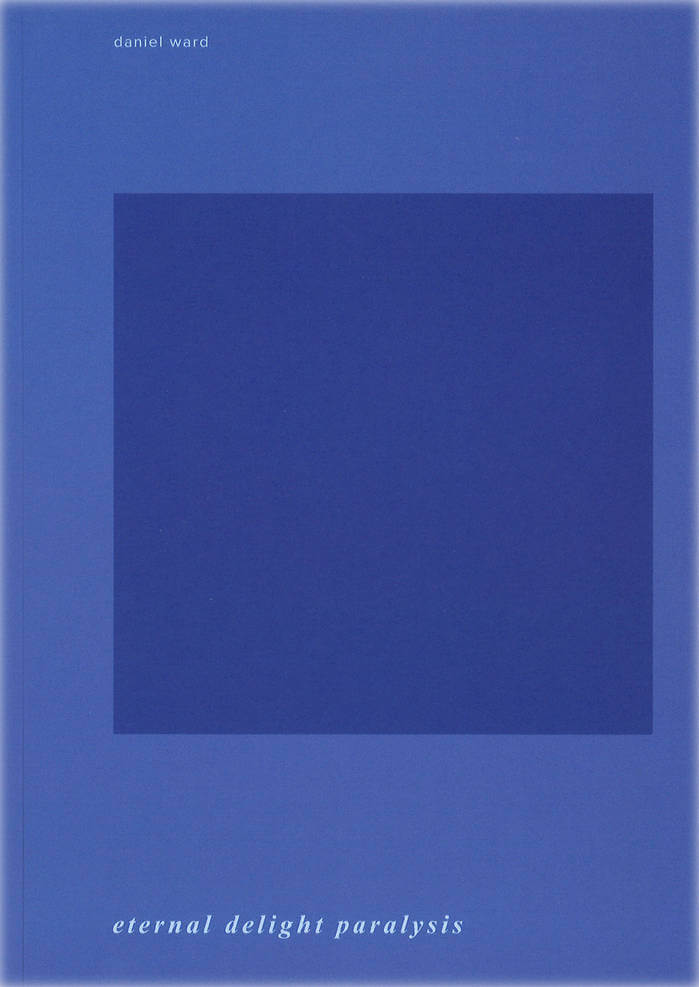
nmp.12 - Eternal Delight Paralysis
"…a book about days and pleasure. the dizzying inaction of life’s excess. it’s an interrogation on the balance of the circle time brings. they are mostly automatic poems. the book feels to be the beginning of a dialogue/catalogue of spirit, in as much as the poems enact a pantheism in their noticing of the body of/as earth. a long ode to witnessing the patterns we lay in avoidance of suffering. it examines a philosophy of patient indifference. and so much else i can’t say, because i’ve spent too long trying to say it. life as the grand poem."—daniel ward reflects on eternal delight paralysis.
nmp.12:
2022, english — paperback
148 pages, 145 x 204 mm
first edition, edition of 200, numbered
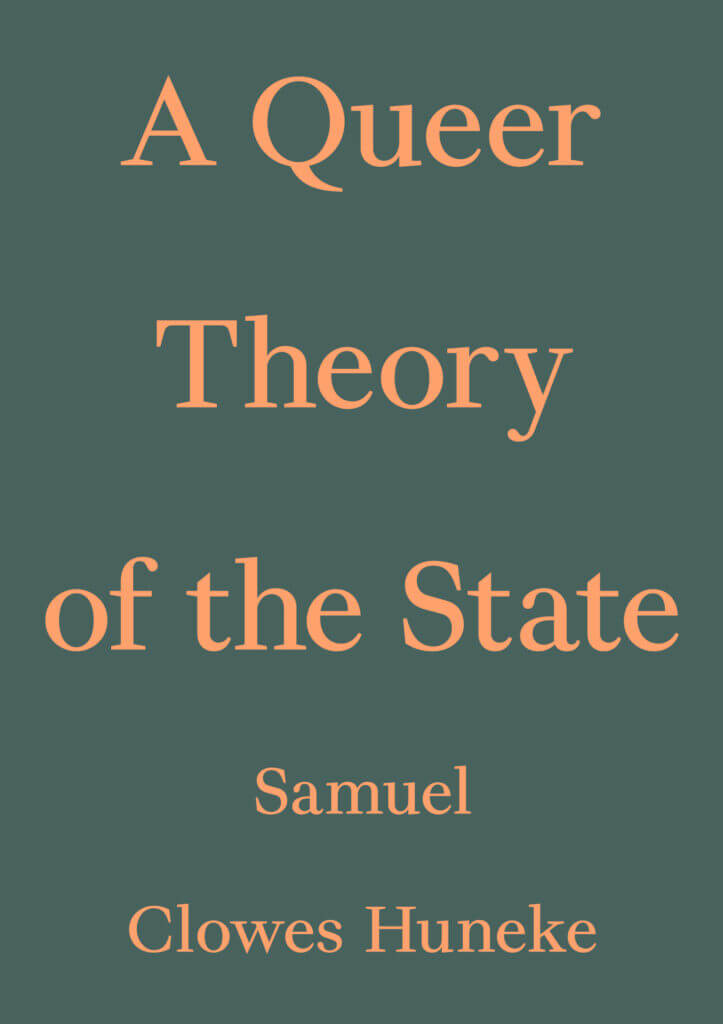
A Queer Theory of the State
How queer theory can wed its critically anti-normative impulses to the empirical need for a state.
Queer theory has often been hesitant to align itself with a politics of the state, approaching it with a negative or pragmatic framework. A Queer Theory of the State offers a more optimistic perspective. Rather than eschew engagement with democratic theorizing, the historian Samuel Clowes Huneke asks how queer theory can wed its critically anti-normative impulses to the empirical need for a state. In answering this question, Huneke shows how the state is an integral component of a politics that seeks to subvert and undo the oppression of queer lives.
Samuel Clowes Huneke is assistant professor of history at George Mason University. His first book, States of Liberation: Gay Men Between Dictatorship and Democracy in Cold War Germany (2022), won the Charles E. Smith Award for best book in European History from the European History Section of the Southern Historical Association. Huneke has written for Boston Review, the Washington Post, The Point, and the Los Angeles Review of Books.

Spectres I: Composer l’écoute / Composing listening
François J. Bonnet, Bartolomé Sanson
[ENG]
This book has been conceived as both a prism and a manual. Following the “traditional” arc of electroacoustic composition (listen—record—compose—deploy—feel), each of the contributions collected together here focuses in on a personal aspect, a fragment of that thrilling territory that is sonic and musical experimentation. Although the term “experimental music” may now have be understood as referring to a genre, or even a particular style, we ought to hold on to the original use of this term, which was based more on an approach than on any particular aesthetic line to be followed. The experimental is first and foremost a spirit, the spirit of the exploration of unknown territories, a spirit of invention which sees musical composition more as a voyage into uncertain territories than as a self-assured approach working safe within the bosom of fully mapped out and recognized lands.
Authors: Félicia Atkinson, François Bayle, François J. Bonnet, Drew Daniel. Brunhild Ferrari, Beatriz Ferreyra, Stephen O’Malley, Jim O’Rourke, Eliane, Radigue, Régis Renouard Larivière, Espen Sommer Eide, Daniel Teruggi,
Chris Watson.
[FR]
Le livre qui suit a été pensé comme un prisme et un manuel. Suivant l’arc « traditionnel » de la composition électroacoustique (écouter — enregistrer — composer —déployer — ressentir), chacune des contributions regroupées ici pointe un aspect personnel, fragment de territoire passionnant qu’est celui de l’expérimentation sonore et musicale. Si le terme de musique expérimentale a pu être assimilé à un genre, voir à un style, il ne faut pour autant pas oublier l’usage initial de ce terme, qui était basé plus sur la démarche que sur la ligne esthétique adoptée.
L’expérimental, en effet, est d’abord un esprit, un esprit d’exploration des territoires inouïs, un esprit d’invention qui voit dans la composition musicale plus un voyage vers des terres incertaines qu’une démarche assurée produisant dans le giron de terres balisées et reconnues.

mnemotope issue 002
This second edition features pieces from 40 contributors that range from soup recipes to poetic essays to drawings to music recommendations to a screenplay and beyond.
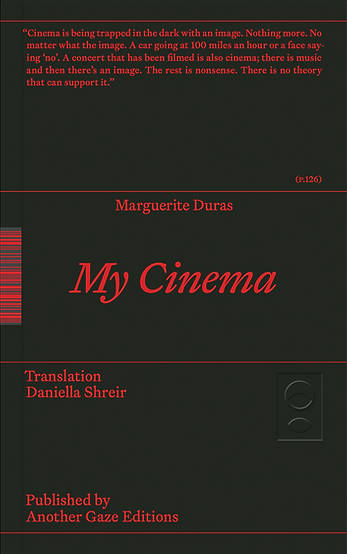
My Cinema
A collection of writings by and interviews with Duras about her filmmaking, first published in French by P.O.L. in 2021 and translated into English by Daniella Shreir.
Working chronologically through her nineteen films, made between 1966 and 1985, this collection of reflections by Marguerite Duras (1914–1996) includes non-standard press releases, notes to her actors, letters to funders, short essays on themes as provocatively capacious as ‘mothers’ and ‘witches’, as well as some of the most significant interviews she gave about her cinematic and writing practices (with filmmakers and critics including Jacques Rivette, Caroline Champetier and Jean Narboni).
In Duras's hands, all of these forms turn into a strange, gnomic literature in which the boundary between word and image becomes increasingly blurred and the paradox of creating a cinema that seeks ‘to destroy the cinema’ finds its most potent expression.
Yet, Duras is never concerned only with her own work, or even with the broader project of making cinema: her preoccupations are global, and the global crucially informs her perceptions of the way in which she works. With the audiovisual as a starting point, her encyclopaedic associative powers bring readers into contact with subjects as diverse as the French Communist Party, hippies, Jews, revolutionary love, madness and freedom, across four decades of an oeuvre that is always in simultaneous dialogue with the contemporary moment and world history.
MARGUERITE DURAS (1914–1996) published over forty novels, numerous essays, novellas and plays and made nineteen films. She was part of the French Resistance, joined then left the Communist Party, and actively protested against the war in Algeria. She collaborated repeatedly with actors including Jeanne Moreau, Delphine Seyrig and Gerard Depardieu. Her films speak of her childhood in Indochina and the French colonies, of desire (burning and frustrated), madness and domesticity. Contemporary filmmakers including Claire Denis, Alice Diop and John Waters have cited Duras’ cinema as inspiration for their own work.

VNOUJE 4
Cécile Bouffard, Roxanne Maillet and 1 more
4ème numéro de l'épopée lesbienne en épisodes par la collective Fusion, ce recueil d'aventures se lit dans n'importe quel ordre.

Whore Foods, Chroniques d'une caissière en chien
LA Warman transforme les rayons d’un supermarché bio en boîte à fantasmes. Des clientes frustrées aux collègues en chaleur, de la boucherie au bar à fruit, de l’orgie à la pause dej’ au booty call dans la chambre froide, chaque recoin du supermarché est propice aux expériences sexuelles de la protagoniste.
Extrait :
« B fait une liste de choses à lécher :
— Du 100% coton, des contenants en plastique fraîchement sortis du lave-vaisselle, tout type de marbre, de la papaye (évidemment,
donner une pichenette aux pépins
avec la langue), des sacs en
plastique remplis de raisin,
n’importe quelle feuille
d’arbre.
— Qu’est-ce que tu lèches
d’autre B ?
— Les pommes, les huîtres,
les prunes, certains
métaux, le pudding, le
lait, les confettis, les vieux
bouts de papier (...) »
.jpg)
Le jukebox des trobairitz
Esmé Planchon, Clara Pacotte and 1 more
D'Alexandrine à Zizanie, 101 définitions mythologiques, topographiques, et poétiques, inventées par Helena de Laurens, Clara Pacotte & Esmé Planchon, inspirées par le Brouillon pour un dictionnaire des amantes de Monique Wittig & Sande Zeig, publié en 1976.

Viscose 05: Retail
Viscose is a journal for fashion criticism. The fifth issue of Viscose explores fashion’s multifaceted retail spaces and cultures. With the evolution of shopping in the 20th and 21st centuries as its focus, the issue looks at the shop as a central nexus where communities and identities are continuously produced and re-imagined through commerce. With a special attention to the role of fashion retail within urban spatial politics, we seek out histories of projects—often developed with or by artists—that have embraced the shop as a medium of both possibility and contestation.
With contributions by:
Dennis Brzek, Anastasia Howe Bukowski, Michael Bullock, Felix Burrichter, Canal Street Research Association, Noah Dillon, Harun Farocki, Anna Franceschini, Ignacio Gatica, Christian Hincapié, Juje Hsiung, Jessica Kwok, Rhonda Lieberman, Matthew Linde, Marge Monko, Cheuk Ng, Luis Ortega, Camila Palomino, Andreas Petrossiants, Leah Pires, International Library For Fashion Research, Vésma Kontere Mcquillan (International Library For Fashion Research), Rose Salane, Alice Sarmiento, Museum Of Modern Shopping, Jeppe Ugelvig, Sean Vegezzi, Post Vsop, Evie Ward, Leah Weirer
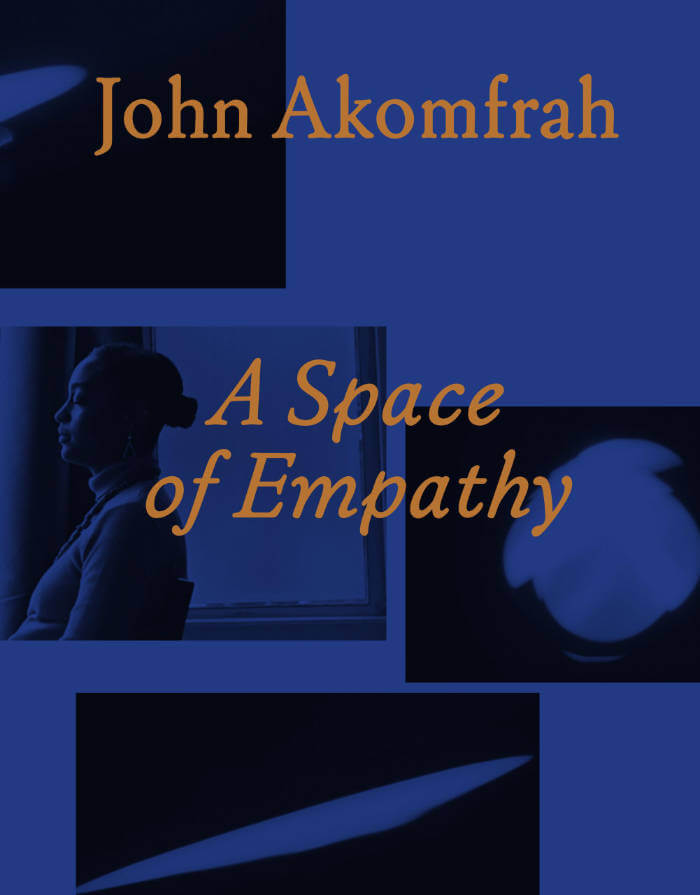
A Space of Empathy
An overview of John Akomfrah's work, with contributions by Julia Grosse and Nelly Y. Pinkrah, an interview with the artist, along with a foreword by Sebastian Baden.
John Akomfrah creates thoughtful video works of haunting audiovisual intensity. He tells of the radical changes and crises of the present and past on characteristic large-format screens. From November 9, 2023 to January 28, 2024, the Schirn Kunsthalle Frankfurt is presenting for the first time a comprehensive overview of the artist's work in Germany, featuring a selection of three major multichannel installations from recent years: The Unfinished Conversation (2012), Vertigo Sea (2015), and Akomfrah's new work, Becoming Wind (2023). A co-founder of the influential London-based Black Audio Film Collective (established in 1982), Akomfrah's work interweaves newly shot film sequences with archival material to create multilayered, at times associative collages, frequently in the form of simultaneous narrative structures.
Akomfrah's immersive installations critically examine colonial pasts, global migration, and the climate crisis. He addresses one-dimensional historical representations by allowing multiple perspectives to emerge in the narrative, disrupting the notion of linearity and the illusion of a one and only truth.
Published on the occasion of the eponymous exhibition at Schirn Kunsthalle Frankfurt in 2023-2024.
John Akomfrah (born 1957) is a British artist, writer, film director, screenwriter, theorist and curator. His works are characterised by their investigations into memory, post-colonialism, cultural identity, temporality and aesthetics and often explores the experiences of migrant diasporas globally. Akomfrah was a founding member of the influential Black Audio Film Collective, which started in London in 1982 alongside the artists David Lawson and Lina Gopaul, who he still collaborates with today.
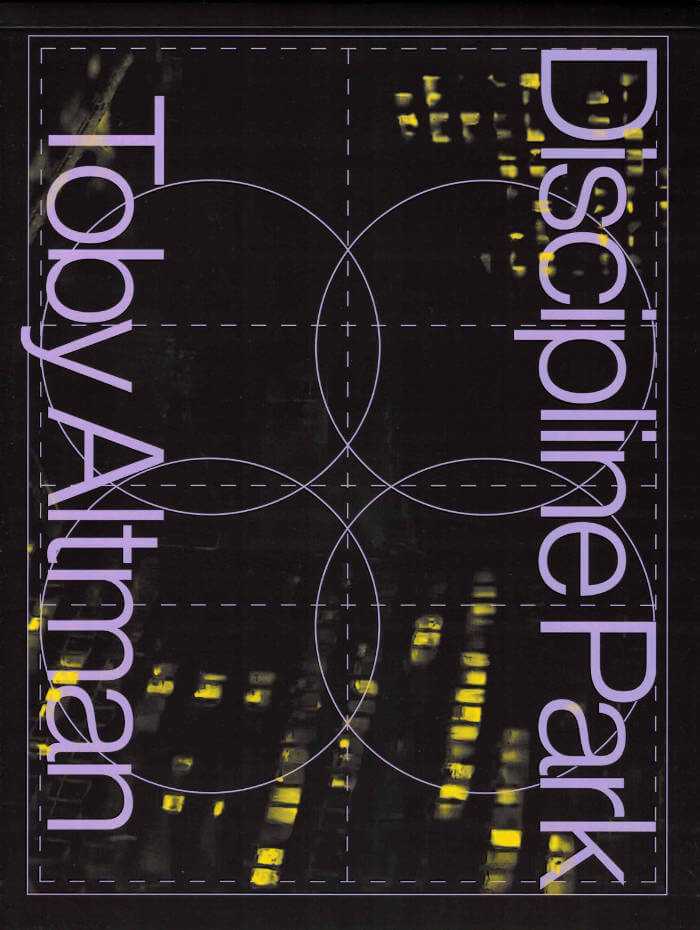
Discipline Park
Toby Altman’s Discipline Park documents the demolition of Prentice Women's Hospital in Chicago, a landmark of architectural brutalism designed by Bertrand Goldberg in the 1970s. Altman was born in the building, and years later, was employed by Northwestern University when they tore it down. His personal proximity to the site leads to a wider critical evaluation of the cruelty of a neoliberalism that asks us to draw sustenance from the very institutions that poison and erase our bodies, habitats, and histories. But, as it indicts the present and its claustrophobic, ruinous politics, Discipline Park also recovers or reinvents utopian vistas through an extended engagement with Goldberg's architectural practices.
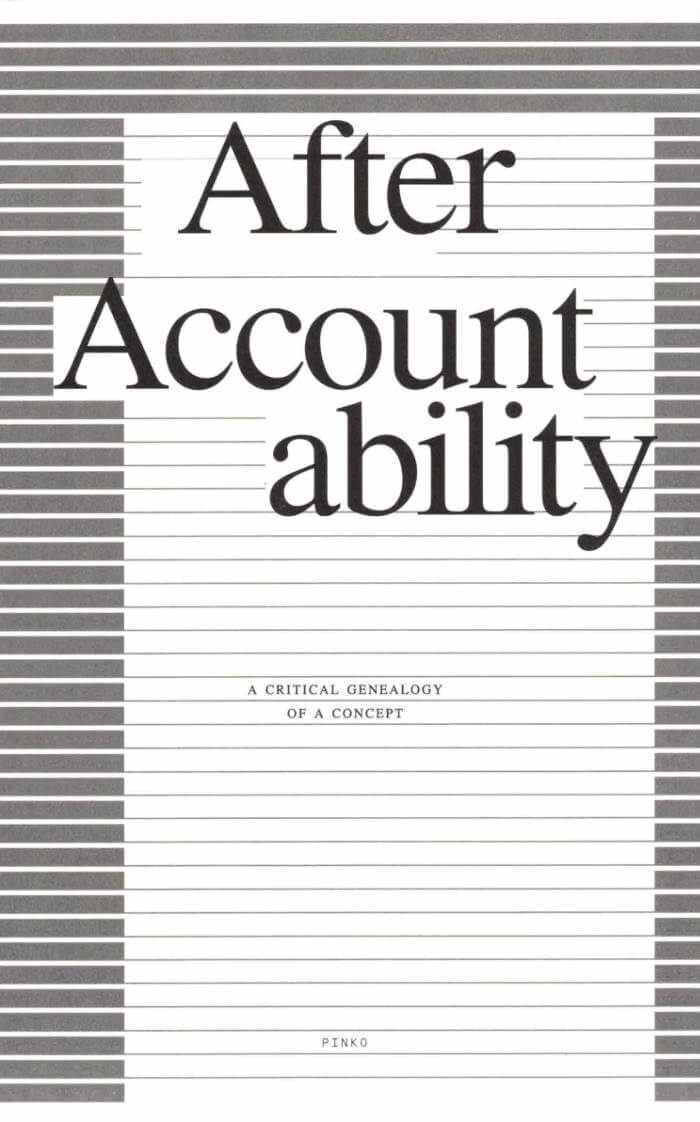
After Accountability
A concept just short of a program, accountability has been taken up as a core principle within leftist organizing and activity over the past quarter century. While it invokes a particular vocabulary and set of procedures, it has also come to describe a more expansive, if often vague, approach to addressing harm within movement work. The term’s sudden, widespread adoption as abolitionist concepts began to circulate broadly in recent years cast light on certain shifts in its meaning, renewing the urgency of understanding its relation to militant history and practice.
After Accountability is an oral history and critical genealogy of this decisive movement concept that gathers interviews with eight transformative justice practitioners, socialist labor organizers, incarcerated abolitionists, and activists on the left conducted by members of the Pinko collective. An investigation into the theoretical foundations and current practice of accountability, this volume explores the term’s potential and limits, discovering in it traces of the past half-century’s struggles over the absence of community and the form revolutionary activity should take.
Pinko is a collective for thinking gay communism together. Pinko publishes a biannual print issue and periodic zines, and hosts irregular essays, translations, and archival material on their website.
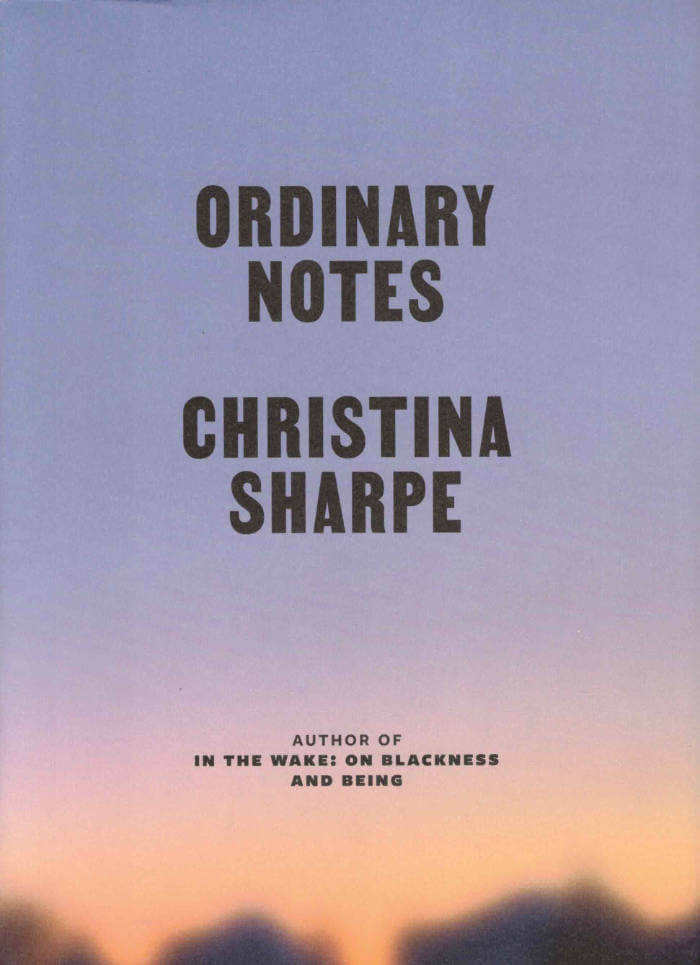
Ordinary Notes
A singular achievement, Ordinary Notes explores profound questions about loss and the shapes of Black life that emerge in the wake. In a series of 248 notes that gather meaning as we read them, Christina Sharpe skillfully weaves artifacts from the past—public ones alongside others that are poignantly personal—with present realities and possible futures, intricately constructing an immersive portrait of everyday Black existence. The themes and tones that echo through these pages—sometimes about language, beauty, memory; sometimes about history, art, photography, and literature—always attend, with exquisite care, to the ordinary-extraordinary dimensions of Black life.
At the heart of Ordinary Notes is the indelible presence of the author’s mother, Ida Wright Sharpe. “I learned to see in my mother’s house,” writes Sharpe. “I learned how not to see in my mother’s house . . . My mother gifted me a love of beauty, a love of words.” Using these gifts and other ways of seeing, Sharpe steadily summons a chorus of voices and experiences to the page. She practices an aesthetic of "beauty as a method,” collects entries from a community of thinkers toward a “Dictionary of Untranslatable Blackness,” and rigorously examines sites of memory and memorial. And in the process, she forges a brilliant new literary form, as multivalent as the ways of Black being it traces.